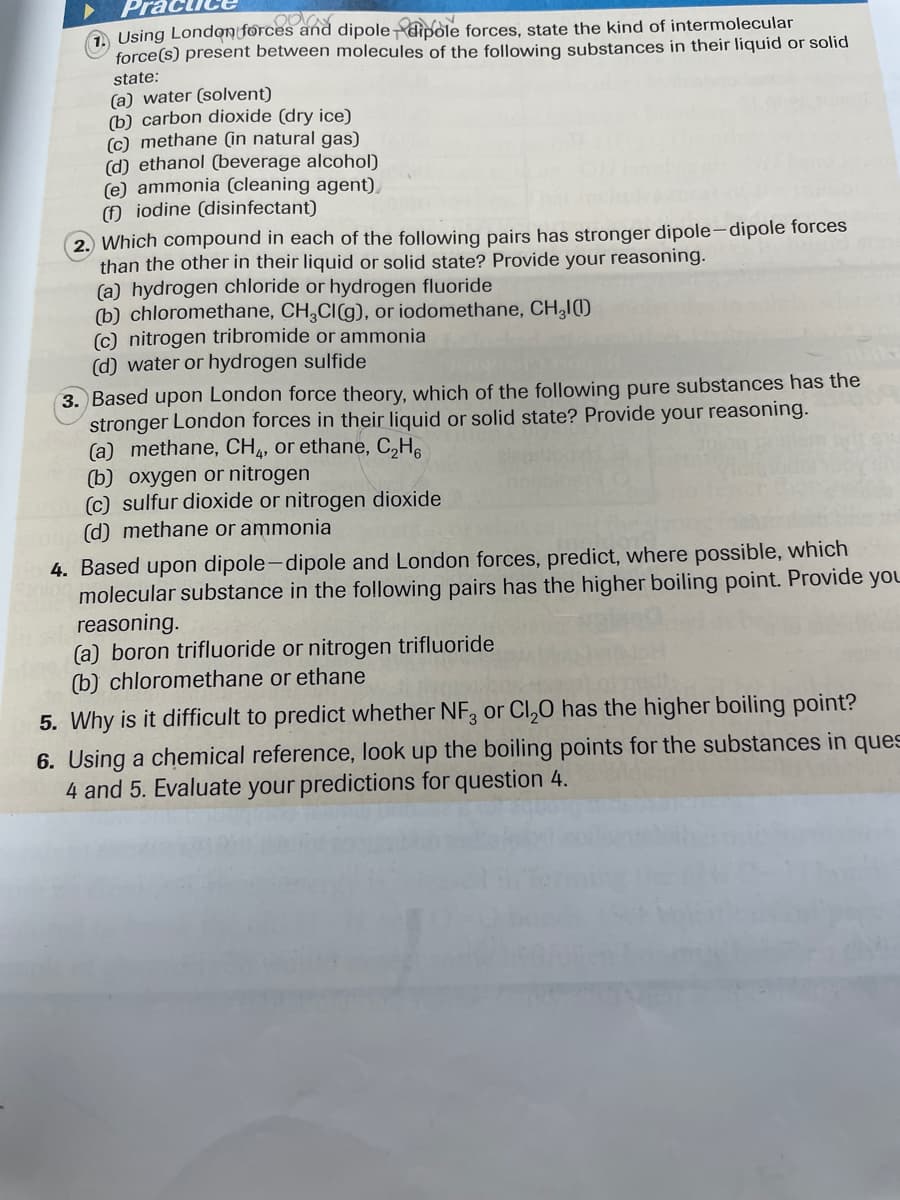A Using London forces and dipole dipòle forces, state the kind of intermolecular force(s) present between molecules of the following substances in their liquid or solid state: (a) water (solvent) (b) carbon dioxide (dry ice) (c) methane (in natural gas) (d) ethanol (beverage alcohol) (e) ammonia (cleaning agent), O iodine (disinfectant) dinole forces
A Using London forces and dipole dipòle forces, state the kind of intermolecular force(s) present between molecules of the following substances in their liquid or solid state: (a) water (solvent) (b) carbon dioxide (dry ice) (c) methane (in natural gas) (d) ethanol (beverage alcohol) (e) ammonia (cleaning agent), O iodine (disinfectant) dinole forces
Chemistry: An Atoms First Approach
2nd Edition
ISBN:9781305079243
Author:Steven S. Zumdahl, Susan A. Zumdahl
Publisher:Steven S. Zumdahl, Susan A. Zumdahl
Chapter9: Liquids And Solids
Section: Chapter Questions
Problem 10RQ
Related questions
Question

Transcribed Image Text:A Using London forces and dipole ¬dipòle forces, state the kind of intermolecular
force(s) present between molecules of the following substances in their liquid or solid
state:
(a) water (solvent)
(b) carbon dioxide (dry ice)
(c) methane (in natural gas)
(d) ethanol (beverage alcohol)
(e) ammonia (cleaning agent),
O iodine (disinfectant)
2. Which compound in each of the following pairs has stronger dipole-dipole forces
than the other in their liquid or solid state? Provide your reasoning.
(a) hydrogen chloride or hydrogen fluoride
(b) chloromethane, CH,CI(g), or iodomethane, CH,I)
(c) nitrogen tribromide or ammonia
(d) water or hydrogen sulfide
3. Based upon London force theory, which of the following pure substances has the
stronger London forces in their liquid or solid state? Provide your reasoning.
(a) methane, CH,, or ethane, C,H6
(b) oxygen or nitrogen
(c) sulfur dioxide or nitrogen dioxide
(d) methane or ammonia
4. Based upon dipole-dipole and London forces, predict, where possible, which
molecular substance in the following pairs has the higher boiling point. Provide you
reasoning.
(a) boron trifluoride or nitrogen trifluoride
(b) chloromethane or ethane
5. Why is it difficult to predict whether NF, or Cl,0 has the higher boiling point?
6. Using a chemical reference, look up the boiling points for the substances in ques
4 and 5. Evaluate your predictions for question 4.
Expert Solution
This question has been solved!
Explore an expertly crafted, step-by-step solution for a thorough understanding of key concepts.
This is a popular solution!
Trending now
This is a popular solution!
Step by step
Solved in 2 steps

Recommended textbooks for you

Chemistry: An Atoms First Approach
Chemistry
ISBN:
9781305079243
Author:
Steven S. Zumdahl, Susan A. Zumdahl
Publisher:
Cengage Learning


Chemistry
Chemistry
ISBN:
9781305957404
Author:
Steven S. Zumdahl, Susan A. Zumdahl, Donald J. DeCoste
Publisher:
Cengage Learning

Chemistry: An Atoms First Approach
Chemistry
ISBN:
9781305079243
Author:
Steven S. Zumdahl, Susan A. Zumdahl
Publisher:
Cengage Learning


Chemistry
Chemistry
ISBN:
9781305957404
Author:
Steven S. Zumdahl, Susan A. Zumdahl, Donald J. DeCoste
Publisher:
Cengage Learning

Chemistry for Engineering Students
Chemistry
ISBN:
9781337398909
Author:
Lawrence S. Brown, Tom Holme
Publisher:
Cengage Learning

Introductory Chemistry: A Foundation
Chemistry
ISBN:
9781337399425
Author:
Steven S. Zumdahl, Donald J. DeCoste
Publisher:
Cengage Learning

Chemistry for Engineering Students
Chemistry
ISBN:
9781285199023
Author:
Lawrence S. Brown, Tom Holme
Publisher:
Cengage Learning